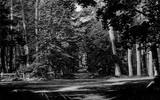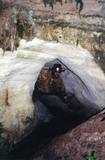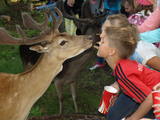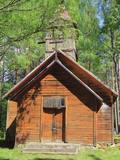| Nr | Name | Beschreibung |
|---|---|---|
|
Piedāvā ļoti gardus Lietuviešu tradicionālos ēdienus. Var pieņemt līdz 140 personām. Ir āra terase un dzīvā mūzika. Pieņem bankas kartes, pieejama autostāvvieta. |
||
|
The cafe Kolumbine is situated in the suburb of Talsi city, about 1,5 km away from the centre. |
||
|
Es ist eines der seltenen Angebote in der Region Latgale, wo der Reiseleiter während der Führung in der lettgallischen Mundart singt. Es ist eine fesselnde und attraktive Erzählung über historische Ereignisse, die mit dem Landgut von Preiļi und mit dieser Stadt verbunden sind. |
||
|
Diese Tour ist ein Roadtrip von Rīga nach Vilnius. Unterwegs werden Sie kleine Abschnitte des baltischen Diese Tour eignet sich für Reisende, die die Natur, sowie die urbane Landschaft besichtigen möchten, die aber nicht auf längere Wanderungen mit Rucksäcken, Zeltengehen u.ä. bereit sind. Ein Auto bringt Sie von einer kurzen Wanderung zur nächsten. Ein weiterer Transfer ist von der Insel Rusnė in das Dubysa-Flusstal geplant, wodurch die litauischen Abschnitte des baltischen Küstenwanderweges und des Wald-Wanderweges miteinander verbunden werden. Die Tour umfasst die lettischen und litauischen Naturwerte – die Nationalparks Ķemeri und Slītere, das Kap Kolka, den Naturpark Pape, die Kurische Nehrung, die Insel Rusnė, den Fluss Nemunas, den Regionalpark des Dubysa-Flusstals mit seinem hügeligen Gelände, sowie das waldreiche und menschenleere Gebiet Litauens – den Nationalpark Dzūkija. Neben den Hauptstädten beider Länder führt Sie die Route zu anderen großen Städten – Ventspils, Liepāja, dem beliebten Kurort der Kurischen Nehrung – Nida, sowie zu historischen Badeorten: Ķemeri, Birštonas und Druskininkai. Sie werden auch die Stadt Kaunas und die wunderschönen Flusslandschaften des Flusses Nemunas (dt. Memel) sehen. |
||
|
Die heutige Kirche aus Holz wurde auf diesem Hügel im Jahr 1947 gebaut, aber sie ist erneuert worden. Heute befindet sich in der Kirche das Dekanat von Rēzekne. Die Kirche kann man von außen besichtigen. Im Dorf Dukstigals waren bis zum Jahr 1960 zwei Gemeinden: Das Weiße Dukstigals (von Šadurskis) und das Schwarze Dukstigals (von Slobodskis). Im Weißen Dukstigals wurde eine Kirche im Jahr 1775 gebaut. Diese Kirche hat die Sowjetmacht im Jahr 1960 gewalttätig zerstört. Und das wurde trotz der Tatsache gemacht, dass diese Kirche ein Baudenkmal und die älteste Kirche (367 Jahre alt) in der Region Latgale war! Eine Rechtfertigung war die Erklärung, dass sich in einer Gemeinde zwei Kirchen nicht befinden dürfen. |
||
|
The tour combines the most beautiful southern parts of the Forest Trail in Lithuania and Latvia. The route starts in Druskininkai, Lithuania, and for the next day you will walk through forests of the Dzūkija National Park. After getting to Vilnius and Kurtuvėnai Regional Park, two sections of the Forest Trail will take you from Dengtiltis to Šaukėnai. Since it is among the most forested areas of Central Lithuania, the Kurtuvėnai Regional Park with its glaciated valleys is a wonderland of forests, waters and wetlands. The Forest Trail will run along small forest paths, tourist trails, beautiful tree alleys and wetlands. Next you will take public transportation to reach the Žemaitija National Park, where you will taketwo sections of the Forest Trail from the pilgrimage town of Žemaičių Kalvarija along the lakes of Plateliai, Ilgis and Beržoras to the town of Plateliai. It is one of the most beautiful towns of Samogitia taking pride in its manor park and the viewing platform on Lake Plateliai. Žemaitija National Park takes pride in its old pine and fir forests, as well as mixed forests. From there on the Forest Trail takes you along the riverside promenade in Kuldīga, continues through the nature park “Abavas senleja” from Renda to the wine and cider town Sabile and Kandava. The section along the Abava River Valley Nature Park is the most diverse river valley in Kurzeme in terms of landscapes and terrain. The final section of the tour takes you to the Ķemeri National Park, which is an important place for the protection of wetlands. As to the town – Ķemeri – it is the former balneological and sulphur springs resort. The tour ends on the seaside – the village of Bigauņciems, from where you can easily get to Rīga. Optionally, one can take a detour along the Lake Sloka trail with its bird-watching tower or pay a visit to the “Forest House” – the visitor’s centre of the Ķemeri National Park. |
||
|
Construction of the Neibāde resort in 1823, started up hospitality traditions. The park, designed in an English style, was created by the gardener Akerbergs, who was brought from Estonia by Baron August von Pistohlkors. In the 1920s – 1930s the Pēterupe – Neibāde Seashore Aid and Improvement Society looked after the restoration and care of the monument and the park of the resort that was ruined during the war, the appearance of Saulkrasti, the organisation of different events and foundation of the theatre and the choir, led by Olga Cīrule. Saulkrasti open-air stage has always been a place for festivities. 16 July 1933 is a date that deserves special attention as it was on this date that the open-air stage became the place where Neibāde and Pēterupe were renamed Saulkrasti. The open-air stage was repeatedly rebuilt and improved. Both during the Soviet era, as well as later, this was a meeting place for locals on joyful moments, on moments of change and remembrance. The stage was the place of origin of the Popular Front of Latvia (Latvijas Tautas fronte) Saulkrasti branch. Now the stage is a meeting place and holds different events on summer weekends. Each year Saulkrasti town festival concert takes place on this open-air stage. |
||
|
The owner of the farm grows petunias, geraniums, balsams, asters, snapdragons and other plants, also designing beautiful pots of flowers. She organises seminars on biological farming. Visitors can purchase plants, pick black currants from a bush, and pick tomatoes from a vegetable bed. Tastings are available, and there are rabbits on display, as well. |
||
|
Auf den 2 ha der Bauernwirtschaft "Lielkalni" werden seit 2006 ungewöhnliche Beerensträucher gepflanzt: Gold-Johannisbeeren, Drosselbeeren, Lamberthaseln, Sanddorn, Schwarze Holunder, Chinesisches Spaltkörbchen, Scharfzähnige Strahlengriffel, Essbare Geißblätter u.a. Seit 2008. ist die Bauernwirtschaft als biologische Landwirtschaft zertifiziert. 2009. wurde das Gesundheits- und Veterinärdienstzertifikat erhalten. Die Eigentümer haben angefangen gesundheitsstärkende Sirupe, Gelees, Konfitüre und Tees zu fertigen und zu verkaufen. Die Besucher können verschiedene Teesorten, saisonale Beeren, Sirupe, Gelees und andere Leckerbissen probieren und sie auch für sich zulegen.
|
||
|
"Anima Candles" sveces ir roku darbs. Svecēm pieejami vairāki dizaini, kas variē gan krāsās, gan izgatavošanas metodē. Krāsu un smaržu klāsts ir plaši pieejams. Tās izgatavotas no pārtikas rūpniecībā izmantojamā parafīna vai ekoloģiskās sojas. Sveču ražotnē tiek piedāvātas sveču liešanas meistarklases.
|
||
|
Die Gastgeberin des Strandhauses Tahku organisiert Workshops zum Marinieren und Einlegen von Gurken. Dabei herrscht eine fröhliche Atmosphäre. Das Gurkenfest Tahkuranna findet jedes Jahr am 20. August statt. Man kann dort auch Gurkenkonserve, lokale Lebensmittelprodukte und Handwerkserzeugnisse kaufen sowie Handwerkserzeugnisse selbst herstellen. |
||
|
Atrodas Raganas centrā pie degvielas uzpildes stacijas, viesnīcā „Raganu ligzda”. Piedāvā mūsdienīgu Latvijas virtuves ēdienkarti. Kompleksās pusdienas. Sadarbojas ar vietējām zemnieku saimniecībām. |
||
|
Zemnieku saimniecības "Imantas" galvenais darbības virziens ir olu ražošana. Te iespējams apskatīt lauku saimniecībā dzīvojošos dzīvniekus un dažādu šķirņu vistas, uzzinot kaut ko jaunu vai sen piemirstu par vistām un olām. Piedāvā arī iegādāties lauku olas. |
||
|
Vairāki dažus metrus augsti smilšakmens atsegumi, kas izveidojušies Stiglavas (Stiglovas) strauta gravas nogāzēs. Kaut arī teritorija tiek popularizēta kā tūrisma objekts, tajā nav īpašu šim nolūkam paredzētu labiekārtojumu. Teritorijas apmeklētāji bojā smilšakmens atsegumus, kas ir aizsargājami biotopi!
|
||
|
Leichte Kost mit reinem Geschmack, das zu Großmutters Zeit noch alltäglich war, jetzt aber als Privileg der Gourmets angesehen wird. Es werden die gerade für diese Gegend charakteristischen Gerichte angeboten. Dass die Rohprodukte rein sind und aus der nächsten Gegend kommen, ist selbstverständlich. |
||
|
Some 200 fallow deer live in large paddocks at the park, and the largest deer sorting facility in the Baltic States is right next door. You can look at the animals from up close. The owner organises educational camps for children and offers consultations on the breeding of animals. |
||
|
Krupenišku Old-Believer Prayer House was built in 1908. The autor of the
design is engineer I. Ivanov. At present the church is in bad tehnical condition.
|
||
|
Der aus Holstegen und Brücken angelegte Weg führt an einem schönen Abschnitt mit mehreren Wasserfällen und -stufen und der Ieriķupīte entlang und weiter zur alten Mühle mit dem einzigartigen Mühlrad. Es gibt auch die Möglichkeit, sich in Begleitung eines Führers an einigen Hindernissen zu versuchen.
|
||
|
The Slocene River flows through Lake Valgums and Lake Mazezers before flowing into the western part of Lake Kaņieris. It is part of a branched and swampy delta in which there are seasonal restrictions aimed at protecting birds. The wetlands which are alongside the river are difficult to access in many places. Before the Starpiņupīte was dug between Lake Kaņieris and the Bay of Rīga (the water level is regulated with sluices), the water from the river flowed along what is now the Vecslocene River all the way to Sloka, where it ended at the Lielupe River. The Vecslocene can be used by canoe boats only when the water level is high and then from the Old Ķemeri road to the place where the river enters the Lielupe. Between Milzkalne and Lake Valgums, the river is not navigable because of many fallen trees. During the springtime, the estuary of the Starpiņupīte is a good place for bird watching. |
||
|
Der Pavillon ist zu Jahrhundertwende 19.-20. Jh. gebaut worden. Neben dem Pavillon – am rechten Ufer des Flusses Vēršupīte – befindet sich eine der bekanntesten Schwefelquellen in Lettland, die sogenannte Ķirzaciņa (die kleine Eidechse). Die Quelle fließt aus der Gestalt einer Eidechse, die im Jahr 1949 aus Stein (Bildhauer Juris Bajārs) gemeißelt wurde. Das Wasser der Quelle ist gesund sowohl zum inneren, als auch zum äußeren Gebrauch. Unweit von dem Pavillon kann man das Alleezeichen von Jānis Lībietis besichtigen, der von 1928 bis 1944 als Direktor der staatlichen Schwefelquellenanstalt von Ķemeri gearbeitet hat. |
||


























